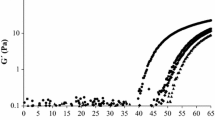Abstract
The effects of pH (6.7 or 5.8), protein concentration and the heat treatment conditions (70 or 90 °C) on the physical properties of heat-induced milk protein gels were studied using uniaxial compression, scanning electron microscopy, differential scanning calorimetry, and water-holding capacity measurements. The systems were formed from whey protein isolate (10–15% w/v) with (5% w/v) or without the addition of caseinate. The reduction in pH from 6.7 to 5.8 increased the denaturation temperature of the whey proteins, which directly affected the gel structure and mechanical properties. Due to this increase in the denaturation temperature of the β-lactoglobulin and α-lactalbumin, a heat treatment of 70 °C/30 min did not provide sufficient protein unfolding to form self-supporting gels. However, the presence of 5% (w/v) sodium caseinate decreased the whey protein thermo stability and was essential for the formation of self-supporting gels at pH 6.7 with heat treatment at 70 °C/30 min. The gels formed at pH 6.7 showed a fine-stranded structure, with great rigidity and deformability as compared to those formed at pH 5.8. The latter had a particulate structure and exuded water, which did not occur with the gels formed at pH 6.7. The addition of sodium caseinate led to less porous networks with increased gel deformability and strength but decreased water exudation. The same tendencies were observed with increasing whey protein concentration.





Similar content being viewed by others
References
S.P.F.M. Roefs, K.G. de Kruif, Eur. J. Biochem. 226, 883–889 (1994)
J.M. Aguilera, Food Technol. 49, 83–89 (1995)
G.R. Ziegler, E.A. Foegeding, Adv. Food Nutr. Res. 34, 203–298 (1990)
S. Ikeda, V.J. Morris, Biomacromolecules 3, 382–389 (2002)
M. Stading, A.M. Hermansson, Food Hydrocoll. 5, 339–352 (1991)
S. Ikeda, E.A. Foegeding, T. Hagiwara, Langmuir 15, 8584–8589 (1999)
W. Sittikijyothin, P. Sampaio, M.P. Gonçalves, Food Hydrocoll. 21, 1046–1055 (2007)
E. Ibanoglu, Food Chem. 90, 621–626 (2005)
R.I. Baeza, A.M.R. Pilosof, Food Sci. Technol. 35, 393–399 (2002)
M. Paulsson, P. Dejmek, J. Dairy Sci. 73, 590–600 (1990)
J.C. Montejano, D.D. Hamann, T.C. Lanier, J. Texture Stud. 16, 403–424 (1985)
E.A. Foegeding, Food Biophys. 1, 41–50 (2006)
AOAC, Official Methods of Analysis, 14th edn. (Association of Official Analytical Chemists, Washington, 1985)
J.F. Steffe, Rheological methods in food process engineering (Freeman, East Lansing, 1996)
P. Schkoda, A. Hechler, H.G. Kessler, Int. Dairy J. 9, 269–273 (1999)
J.I. Boye, I. Alli, Food Res. Int. 33, 673–682 (2000)
D. Christ, K.P. Takeuchi, R.L. Cunha, J. Food Sci. 70, E230–E238 (2005)
D.M. Mulvihill, M. Donovan, Ir. J. Food Sci. Technol. 11, 43–75 (1987)
P. Relkin, D.M. Mulvihill, Crit. Rev. Food Sci. Nutr. 36, 565–601 (1996)
E.H.C. Bromley, M.R.H. Krebs, A.M. Donald, Eur. Phys. J. E Soft Matter 21, 145–152 (2006)
M. Stading, M. Langton, A.-M. Hermansson, Food Hydrocoll. 7, 195–212 (1993)
S. Varunsatian, K. Watanabe, S. Hayakawa, R. Nakamura, J. Food Sci. 48, 42–70 (1983)
I.J. Haug, H.M. Skar, G.E. Vegarud, T. Langsrud, K.I. Draget, Food Hydrocoll. 23, 2287–2293 (2009)
N.K.D. Kella, J.E. Kinsella, Biochem. J. 255, 113–118 (1988)
M. Langton, A.-M. Hermansson, Food Hydrocoll. 7, 11–12 (1993)
M. Langton, A.-M. Hermansson, Food Hydrocoll. 7, 195–212 (1993)
C. Öhgren, M. Langton, A.-M. Hermansson, J. Mater. Sci. 39, 6473–6482 (2004)
T. Lefèvre, M. Subirade, Biopolymers 54, 578–586 (2000)
M. Verheul, S.P.F.M. Roefs, Food Hydrocoll. 12, 17–24 (1998)
Acknowledgments
This work was supported by the Fundação de Amparo à Pesquisa e Desenvolvimento de São Paulo (FAPESP—Brazil; Grant No. 2003/08119-5), and the Brazilian National Research Council (CNPq, Brazil).
Author information
Authors and Affiliations
Corresponding author
Rights and permissions
About this article
Cite this article
Picone, C.S.F., Takeuchi, K.P. & Cunha, R.L. Heat-Induced Whey Protein Gels: Effects of pH and the Addition of Sodium Caseinate. Food Biophysics 6, 77–83 (2011). https://doi.org/10.1007/s11483-010-9177-9
Received:
Accepted:
Published:
Issue Date:
DOI: https://doi.org/10.1007/s11483-010-9177-9




